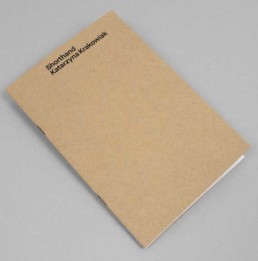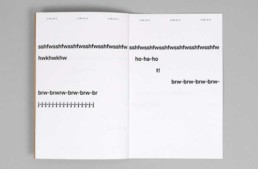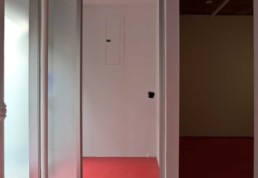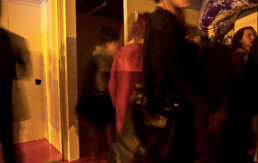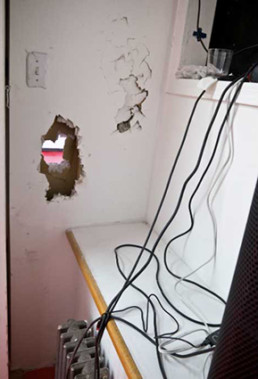Shorthand
curator: Prem Krishnamurthy
P.!, New York, November 2012
http://tumblr.p-exclamation.com/post/36162964343
The work was produced during a studio residence at Residency Unlimited in New York, where a sound sculpture and a performance served to endow silence with a physical dimension. A book, which was the final stage of the process, was prepared by means of stenographic method: all sounds of space collected have been recorded.
The multi-stage production, Shorthand, was the second part of the temporally accumulating exhibition, Possibility 02: Growth, exploring, by means of various ways of space occupation, myths about unrestricted expansion, space gentrification and an impossibility of being situated outside this process.
In the course of one night, the front of former offices at 334 Broome Street, where the exhibition was held, was listened to from a central position – from an interior of an unused closet (a peculiar non-place, a secret observation point), and sounds (operation of the very room, sounds arriving from other parts of the building and from the outside) recorded. Thus created audio document was amplified, so it was fully accessible to the human ear. The ‘white noise’ accompanied visitors to the space as a continuous murmur, emitted by a system of loudspeakers suspended at the entrance to the room, so it was audible both within and without.
A base for a sound sculpture was formed, on which acoustic experiences were superimposed. Throughout the exhibition, the centrally situated closet issued a sound of shaking up the building made by the artist performing inside. Visitors to the gallery and passers-by’s steps were being recorded and gradually added to the soundtrack, and in the course of the week-long installation, the artist herself enriched the soundtrack with further aspects, using elements found within the space and manipulating collected audio material. Ultimately, the sound of this particular silence was written down in signs of the Latin alphabet, in the form of a score or a performance script, making further interpretations possible. Thus, a sound sculpture of several incarnations was made: these were formed by subsequent stages of the process of its emergence taken, both individually and collectively, as successful and mutually enabling.
Shorthand is a workshop approach to the questions of silence, emptiness, translation and extension, breaking away from usual ways of understanding architectural space. Silence (absence) and sound (presence) acquired a different dimension in the multi-stage process of translating space into a record. Attention was drawn to the very process of emergence of an audio experience: first, the compressed air produces a wave, which resonates in the ear, to become, interpreted by the brain, an auditory experience. In the case of language, another level accrues: a particular soundtrack develops into phonemes, and those – into signifying units. The piece, annexing successful sounds arising within its field, precluded being a passive listener, and emphasised the stratified levels of abstraction and their potential for equivocality in the process of translation of one sensual experience into another.
The entire exhibition lasted seven weeks and each artists, in succession, proposed a week-long realisation. The reconfigurations activated a scarce resource – space itself – allowing the pieces to work as separate and potentially oppositional bodies, each of which, in turn, filling the architectural volume. Thus, the exhibition changed in time, accelerated by the accumulation of productions. An appearance of a new work dislodged the previous and redefined space.
The resultant microcosm distances itself from the rhythm of urban growth, and the exhibition was itself an experiment in proliferation and a speculation about ways in which displacement and cohabitation detune conventional exhibition models and social relations, reflected in those modes. An inspiration for the whole laboratory came from Gerard K. O’Neill: “Nothing in our solar system is truly unlimited, of course; no expansion can go on forever; but an exponential growth of wealth can be considered rationally if we can find the environment in which that growth can proceed for many hundreds of years…” (The High Frontier: Human Colonies in Space, 1977).
